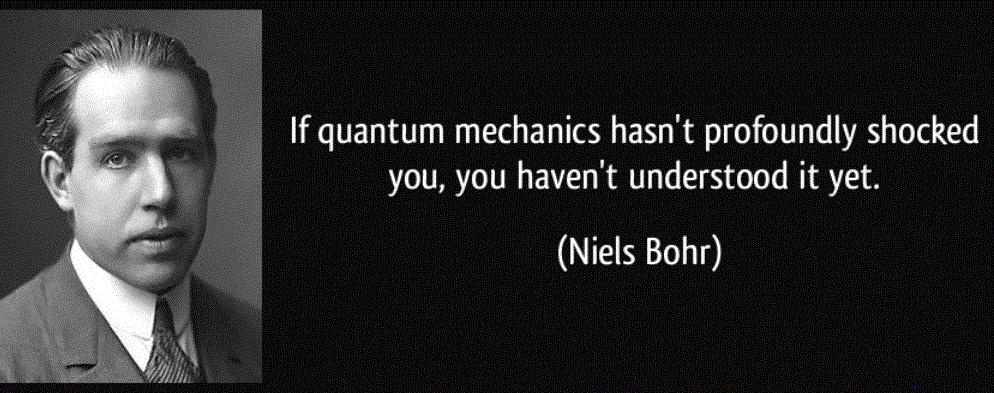A mystery lies at the heart of quantum physics. At the tiniest scales, when a packet of energy (called a quantum) is released during an experiment, the wave packet seems to occupy all space at once. Only when a sensor interacts with it does it take on the behavior of a particle.
Its location can be anywhere, but the odds of finding it at any particular location are random within certain rules of quantum probabilities.

One way to think about this concept is to imagine a quantum “particle” released from an emitter in the same way a child might emit her bubble-gum by blowing a bubble. The quantum bubble expands to fill all space until it touches a sensor, where it pops to reveal its secrets. The “pop” registers a particle with identifiable states at the sensor.
Scientists don’t detect the particle until its bubble pops. The bubble is invisible, of course. In fact, it is imaginary. Experimenters guess where the phantom bubble will discharge by applying rules of probability.
This pattern of thinking, helpful in some ways, is probably profoundly wrong in others. The consensus among physicists I follow is that no model can be imagined that won’t break down.

Scientists say that evidence seems to suggest that subatomic particles don’t exist as particles with identifiable states or characteristics until they are brought into existence by measurements. One way to make a measurement is for a conscious experimenter to make one.
The mystery is this: if the smallest objects of the material world don’t exist as identifiable particles until after an observer interacts in some way to create them, how is it that all conscious humans see the same Universe? How is it that people agree on what some call an “objective” reality?
Quantum probabilities should construct for anyone who is interacting with the Universe a unique configuration — an individual reality — built-up by the probabilities of the particular way the person interfaces with whatever they are measuring. But this uniqueness is not what we observe. Everyone sees the same thing.
John von Neumann was the theoretical physicist and mathematician who developed the mathematics of quantum mechanics. He advanced the knowledge of humankind by leaps and bounds in many subjects until his death in 1954 from a cancer he may have acquired while monitoring atomic tests at Bikini Atoll.
“Johnny” von Neumann had much to say about the quantum mystery. A few of his ideas and those of his contemporary, Erwin Schrödinger, will follow after a few paragraphs.

As for Von Neumann, he was a bonafide genius — a polymath with a strong photographic memory — who memorized entire books, like Goethe’s Faust, which he recited on his death bed to his brother.
Von Neumann was fluent in Latin and ancient Greek as well as modern languages. By the age of eight, he had acquired a working knowledge of differential and integral calculus. A genius among geniuses, he grew-up to become a member of the A-team that created the atomic bomb at Los Alamos.
He died under the watchful eyes of a military guard at Walter Reed Hospital, because the government feared he might spill vital secrets while sedated. He was that important. The article in Wikipedia about his life is well worth the read.
Von Neumann developed a theory about the quantum process which I won’t go into very deeply, because it’s too technical for a blog on the Pontificator, and I’m not an expert anyway. [Click on links in this article to learn more.] But other scientists have said his theory required something like the phenomenon of consciousness to work right.
The potential existence of the particles which make up our material reality was just that — a potential existence — until there occurred what Von Neumann called, Process I interventions. Process II events (the interplay of wave-like fields and forces within the chaotic fabric of a putative empty space) could not, by themselves, bring forth the material world. Von Neumann did hypothesize a third process, sometimes called the Dirac choice, to allow nature to perform like Process I interventions in the apparent absence of conscious observers.

Von Neumann developed, as we said, the mathematics of quantum mechanics. No experiment has ever found violations of his formulas. Erwin Schrödinger, a contemporary of Von Neumann who worked out the quantum wave-equation, felt confounded by Neumann’s work and his own. He proposed that for quantum mechanics to make sense; for it to be logically consistent, consciousness might be required to have an existence independent of human brains — or any other brains for that matter. He believed, like Von Neumann may have, that consciousness could perhaps be a fundamental property of the Universe.
The Universe could not come into being without a Von Neumann Process I or III operator which, in Schrodinger’s view, every conscious life-form plugged into, much like we today plug a television into cable-outlets to view video. This shared consciousness, he reasoned, was why everyone sees the same material Universe.
Billy Lee
Post Script: Billy Lee has written several articles on this subject. Conscious Life and Bell’s Inequality are good reads and contain links to videos and articles. Sensing the Universe is another. Billy Lee sometimes adds to his essays as more information becomes available. Check back from time to time to learn more. The Editorial Board


Cool article!